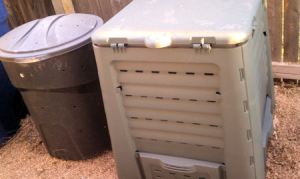Joining the Compost Revolution Easier than You Thought

Hi, I'm SoulMomma, a.k.a. Kim, from The Soulicious Life. I hate to waste, I love to garden, and yet I only just started composting. I can't honestly say what took me so long to join the revolution, but now that I'm on board, I'm hooked! Like many people, I was throwing away mad amounts of fruit and vegetable scraps, not to mention egg shells, coffee grinds, and old flowers down the disposal or into the garbage. The reality is that doing so not only takes up unnecessary space in landfills and bogs down water treatment centers, but also wastes rich nutrients that my outdoor plants were craving. Composting is a completely natural process in which organic matter breaks down into rich new soil; just look at the ground in your local woods or favorite trail for proof. Composting at home provides an easy way to turn small amounts of organic matter, including food scraps and yard waste, into "black gold" loved by gardens beds, bushes, and outdoor containers. Composting is surprisingly easy. It simply calls for a designated area in which your household scraps can decompose. It also requires three key ingredients:
- Brown materials, i.e. dead leaves, branches and twigs, which provide carbon
- Green materials, i.e. grass clippings, vegetable waste, fruit scraps, coffee grounds, and eggshells, which provide nitrogen
- Water, which helps break down the matter

I finished filling my first bin (a black trash can) about one month ago; it's now roughly halfway through the decomposition process.

I'm in the process of filling a second bin now (a more traditional composter purchased at a garden store). Note that the material will significantly decrease in volume as it starts to decompose.[/caption]
Getting Going
As simple as composting is, there is a method to the madness. Here are a few tips to get you started:- Choose the composter that's right for you. If you have the space and are handy, you might build composting stalls in which you toss your scraps directly on the ground and cover with a tarp to keep moist. Alternatively, you can invest in one of the many styles of bins and tumblers available online and in garden stores. A more simple (and less expensive) approach is to utilize a black, lidded trash can by drilling about 30-40 holes throughout it for air circulation.
- Designate an area near a water source so you can easily add moisture as necessary. You'll also want a space somewhat out of sight (and smell) but close enough to your gardens to ease the distribution of finished compost.
- Keep a 50-50 ratio of brown to green material, and alternate the layers as you can.
- Turn your compost pile every week or two to distribute air and moisture. If you don't have a tumbler style composter, investing in a pitchfork or sturdy shovel is a must.
- Eventually, you will have to stop adding materials to the pile so it can decompose completely. Feel free to start a second (or even a third) pile so you always have one to contribute to while the others are finishing up.
- Invest in a small, lidded container to keep next to your kitchen sink; it will ease the scrap collection process.
- The time it take for your material to decompose will vary according to the time of year, materials put in, moisture level, etc.
- When the material in your composter is dark and rich in color, your compost is ready to use!
Thumbs Up
In addition to fruit and vegetable scraps, you can compost these items as well:
- Cardboard rolls
- Clean paper
- Coffee grounds and filters
- Cotton rags
- Dryer and vacuum cleaner lint
- Eggshells
- Fireplace ashes
- Fruits and vegetables
- Grass clippings
- Hair and fur
- Hay and straw
- Houseplants
- Latex balloons
- Leaves
- Nut shells
- Sawdust
- Shredded newspaper
- Tea bags
- Wood chips
- Wool rags
- Yard trimmings
Thumbs Down
Not everything organic should go in your compost heap. According the EPA, leave these items out, and for good reason:- Black walnut tree leaves or twigs. Why? Releases substances that might be harmful to plants.
- Coal or charcoal ash. Why? Might contain substances harmful to plants
- Dairy products (e.g., butter, milk, sour cream, yogurt) and eggs. Why? Creates odor problems and attract pests such as rodents and flies.
- Diseased or insect-ridden plants. Why? Diseases or insects might survive and be transferred back to other plants.
- Fats, grease, lard, or oils. Why? Creates odor problems and attract pests such as rodents and flies.
- Meat or fish bones and scraps. Why? Creates odor problems and attract pests such as rodents and flies.
- Pet wastes (e.g., dog or cat feces, soiled cat litter). Why? Might contain parasites, bacteria, germs, pathogens, and viruses harmful to humans.
- Yard trimmings treated with chemical pesticides. Why? Might kill beneficial composting organisms.



Wish I had the willpower to get out and make a compost heap! Altho I live in the middle of the woods and my dirt is spectacular - just can't grow much except mushrooms because no sunlight gets thru the canopy!
ReplyDelete